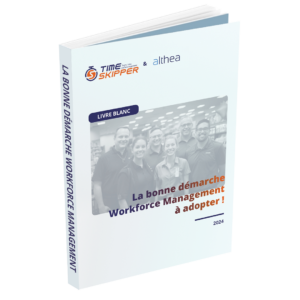The terms “activity management” and “workforce management” are often used to define resource management. But while both solutions involve managing and optimising time and people, they come from different starting points and employ different approaches. Workforce management is based on an HR culture and is used to optimise work schedules: it
schedules the right number of people at the right time. Activity management, on the other hand, is operational in nature and focuses on the work to be done and how to use the available resources to do it. In other words, it involves assigning tasks (and the time needed to complete them) to the right people, at the right time of day, and in the right order of priority. These are two separate approaches with subtle yet noticeable differences.
Workforce management and activity management: two problems, two answers
Workforce management optimises hourly work schedules using a forecast workload. It
answers the question, “how many people are needed to do the forecasted workload in an
optimal way, given existing or easily available staff, their work contracts, their skills and
preferences, and in respect of legal and collective bargaining constraints (overtime, breaks,
etc.)?”.
Activity management aims to optimise teams’ work on a daily basis. It answers the
questions, “who is doing what during working hours? How much time does each task take,
and what are the priorities? How can we spread the workload equitably?”. It is a daily
support for managing people that targets “zero time used poorly” while accounting for
variations in workload.
Calculating the workload: broad forecasts versus real time
Workforce management calculates the number of hours worked at a macro level, based on a forecast volume of workload and in accordance with legal constraints. This calculation helps identify who is working and when. The time horizon is between 1 year and 15 days/3 weeks, taking into account annualisation and employees skills and preferences.
In the first case, the time unit used to optimise schedule calculations has a higher degree of aggregation, which is the only way to obtain accurate schedules. However, this method comes with limits in terms of forecasting. For example, it is hard to predict exactly how many hours will be spent stocking shelves for a delivery of canned meat or vegetables three weeks in advance, because you can never be sure whether the person in charge of the task will be there that day.
Activity management raises the question of what to do with the people who are present. This means defining tasks with a finer time scale and managing priorities according to tasks. But in order to calculate the time needed to carry them out, it is important to know the criteria that influence them. Some of these criteria are actual flows and data that are already known, such as deliveries, promotions in car parks, promotion implementation, and shelf displays.
Others are forecast data related to customer traffic and product sales. Activity management can model the organisation and take into account last-minute data to update product and customer flows as well as attendance times in real time. This is how we can respond to variations in business activity in a highly responsive way. The time horizon is daily (daily schedules to D-3 if delivery volumes are involved), allowing for a much finer and more precise management of resources, thanks to the integration of the most up-to-date information and forecasts.
Workforce management and HRIS: optimising the HR process
While the concept of workforce management is based on the calculation of optimised schedules, we can see two trends in the market:
First, players in workforce management are increasingly expanding their ranges into HRIS (Human Resource Information Systems). Their goal? To streamline, secure and monitor the entire HR process by automating and digitising critical workforce-related processes such as time and attendance, scheduling and leave management, right through to payroll. The retail sector is especially impacted, as its profound structural and organisational transformation calls for a new approach to human capital and time management. Using a workforce management tool that incorporates a complete HRIS software suite can simplify the HR process by:
acquiring and managing talent through specific modules, such as e-recruitment,
interviews, training, careers and skills, administrative management of employees,
and evaluations,managing and optimising time, including absences, time reporting and validation
(time and activity management/badging), activity management and schedule
optimisation (aligning staff numbers with workloads to optimise the wage bill),incorporating payroll modules.
On the other hand, certain workforce management players have specialised in optimising how workloads are calculated for tills and call centres, which follow a traffic absorption approach to reduce waiting times.
Overall, the benefits of workforce management in retail can be summed up as the assurance of having the right number of people working at the right times, and its move into HRIS means that all HR processes can be streamlined to improve productivity.
Activity management: a new and necessary tool for adapting to changes in the retail sector
Activity management opens the door to management on a day-to-day basis, within which the balance between workload and capacity is continuously changing. Volumes change, data is constantly shifting, people are unexpectedly absent, and the weather is not always an
exact science. The world is moving faster and faster, quick reactions are demanded, and what was previously not needed on a regular basis is now a daily concern. It is crucial to have
a more precise understanding of the point of sale’s activity in order to organise it. This allows
us to move towards a fair, day-to-day distribution of a variable workload, with real-time adjustments and verification that all tasks are being carried out correctly, based on updated
data.
Although recording team activity in this way allows us to identify free time on a day-to-day basis so that it can be reassigned or saved, it also constitutes a very rich database which did not exist before. This is then used to create dashboards and reports that can help measure the value of the time used and take operational decisions to improve the customer
experience and shop operations (reinforcing stock checks to avoid stock shortages, reassigning a sales assistant to a particular time slot at a given moment, introducing multi- skilling to meet operational needs, etc.).
We can also use these reports to improve profitability. They provide information to avoid replacing someone on sick leave, to reassign someone to a new activity or to avoid hiring a temporary worker. This precise data gathered from the field can be aggregated, reprocessed and fed into Workforce management tools’ algorithms to improve the quality of their forecasts. An example use case: Timeskipper and its HRIS workforce management partner Holydis work together and integrate with each other very closely: Holydis supplies the initial schedule (the container) to the activity management platform. Timeskipper then sends Holydis the reporting data it has collected, which consists of an analysis of the hours spent in the shop by type of activity (the content). By aggregating this data, the Holydis platform is able to calculate increasingly accurate schedules.
Workforce management solutions amount to optimising the forecasting of the troops whereas activity management optimises operations according to the troops;. Far from being mutually exclusive, these two methods complement each other perfectly when used in the right sequence. First, we recommend optimising how resources are employed by keeping a close eye on what they are doing and using daily records to adjust staffing levels and working hours. Workforce management then comes into play, with relevant, accurate data that can be aggregated to forecast annualised workloads and calibrate and anticipate staffing requirements and schedules.






